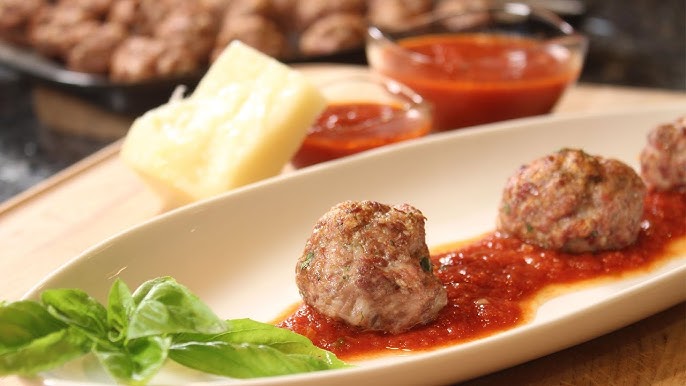Italian Meatball Recipe: Italian meatballs are a beloved classic, famous for their rich flavors, tender texture, and versatility. Whether served atop a bed of spaghetti or soaked in marinara sauce with crusty bread on the side, they are a staple of Italian cuisine.
This recipe takes you step by step, showing you how to craft mouthwatering meatballs that will leave everyone asking for seconds. Perfect for family dinners, gatherings, or meal prepping, this guide ensures you achieve perfect results every time.
Ingredients for Italian Meatballs
To create authentic Italian meatballs, you’ll need fresh, high-quality ingredients. Here’s what to gather:
For the Meatballs:
- 1 lb (500g) ground beef (80/20 for balance of fat and flavor)
- ½ lb (250g) ground pork (optional for richness)
- 1 cup breadcrumbs (preferably Italian-seasoned)
- ½ cup grated Parmesan cheese
- 2 large eggs
- 2 cloves garlic, minced
- 1 tablespoon fresh parsley, chopped
- 1 teaspoon dried oregano
- 1 teaspoon salt
- ½ teaspoon black pepper
- A splash of milk (2–3 tablespoons)
For the Sauce:
- 2 tablespoons olive oil
- 1 medium onion, finely chopped
- 3 cloves garlic, minced
- 1 can (28 oz) crushed tomatoes
- 2 teaspoons tomato paste
- 1 teaspoon sugar
- Fresh basil leaves for garnish
Pro Tip: Always use fresh herbs and high-quality cheese for the best results.
Kitchen Tools You’ll Need
Before diving in, make sure your kitchen is equipped:
- Mixing bowls
- Measuring cups and spoons
- A whisk or fork
- Baking tray or skillet
- Non-stick frying pan or Dutch oven
- Slotted spoon
- Tongs
- Saucepan
Optional tools like a cookie scoop or meat thermometer can help with portioning and checking doneness.
How to Make ITALIAN MEATBALLS
Step 1: Preparing the Meatball Mixture
Start with the meat. In a large bowl, combine ground beef and pork. Add breadcrumbs, Parmesan, eggs, garlic, parsley, oregano, salt, and pepper. For a softer texture, mix in a splash of milk. Use your hands or a wooden spoon to gently mix everything until just combined.
- Key Tip: Avoid overmixing to keep the meatballs tender. Overworking the mixture can result in dense, tough meatballs.
Let the mixture rest for 5–10 minutes to allow the breadcrumbs to absorb moisture, which helps bind everything together.
Step 2: Shaping the Meatballs
Once your mixture is ready, it’s time to shape the meatballs:
- Scoop out uniform portions of the mixture using a tablespoon or small ice cream scoop.
- Roll the portions into balls between your palms, applying light pressure.
- Aim for 1–1.5-inch diameter for standard-sized meatballs.
- Pro Tip: Keep a bowl of water nearby to lightly wet your hands, preventing the mixture from sticking.
Uniform size ensures even cooking, whether you fry, bake, or braise them.
Step 3: Cooking Methods
There are three main methods to cook meatballs:
- Frying: Heat olive oil in a skillet over medium heat. Sear the meatballs on all sides until browned (about 5 minutes). This method gives them a crispy exterior and locks in the juices.
- Baking: Preheat your oven to 375°F (190°C). Place the meatballs on a lined baking tray and cook for 20–25 minutes, turning them halfway through.
- Braising in Sauce: For the juiciest meatballs, simmer them directly in tomato sauce. Add browned or partially baked meatballs to the sauce and cook on low heat for 30–40 minutes.
Making the Perfect Sauce
A good Italian meatball is incomplete without a flavorful sauce. Here’s how to create a rich, traditional tomato sauce:
- Heat the Base: In a saucepan, heat olive oil over medium heat. Add finely chopped onions and sauté until translucent, about 5 minutes. Stir in minced garlic and cook for an additional 30 seconds, until fragrant.
- Add Tomatoes: Pour in crushed tomatoes and stir in the tomato paste for thickness. Add a teaspoon of sugar to balance the acidity of the tomatoes.
- Seasoning: Sprinkle in salt, black pepper, and a few torn basil leaves. You can also add red pepper flakes for a spicy kick.
- Simmer: Reduce the heat to low and let the sauce simmer for at least 20–30 minutes, stirring occasionally to prevent sticking.
- Pro Tip: If the sauce is too thick, add a splash of water or chicken stock. If too thin, let it simmer uncovered to thicken.
This sauce is versatile and can be used with pasta, lasagna, or other Italian dishes.
Combining the Meatballs and Sauce
Once the meatballs are cooked and the sauce is ready, it’s time to bring everything together:
- Place the meatballs gently into the sauce, ensuring they are fully submerged.
- Cover the pan and simmer on low heat for 20–30 minutes. This step allows the meatballs to absorb the flavors of the sauce while staying moist.
- Stir occasionally but gently, so the meatballs retain their shape.
- Key Tip: Taste the sauce before serving and adjust the seasoning if needed. A sprinkle of fresh Parmesan or basil as a garnish adds a final touch.
Serving Suggestions
Italian meatballs are incredibly versatile. Here are a few ways to serve them:
- With Pasta: Serve the meatballs and sauce over spaghetti or fettuccine. Top with grated Parmesan and fresh basil.
- As a Sub: Load the meatballs and sauce onto a toasted sub roll, add mozzarella, and broil until bubbly.
- With Bread: Pair with crusty Italian bread for a hearty appetizer or meal.
- On Their Own: Serve as a protein-packed appetizer with toothpicks for dipping in the sauce.
For a complete Italian feast, add a side salad and a glass of Chianti.
Common Mistakes to Avoid
Even experienced cooks can slip up. Here’s what to watch out for:
- Overmixing the Meat: This can lead to tough, dense meatballs.
- Skipping the Rest Time: Letting the mixture rest ensures the breadcrumbs soak up moisture, binding everything together.
- Undercooking: Always check the internal temperature of meatballs; it should reach 165°F (74°C) for safety.
- Using Lean Meat Only: A mix of lean and fatty meats ensures juicy meatballs.
- Neglecting the Sauce: A bland sauce can ruin even the best meatballs, so taste and season as needed.
Tips for Storing and Reheating
If you’ve made more meatballs than you can eat, no problem! Here’s how to store and reheat them:
- Refrigeration: Store leftover meatballs and sauce in an airtight container in the fridge for up to 4 days.
- Freezing: Arrange cooled meatballs on a baking sheet and freeze until firm. Transfer them to a freezer-safe bag or container. They can be frozen for up to 3 months.
- Reheating: Warm them in a saucepan with sauce over low heat. If reheating from frozen, let them thaw in the fridge overnight.
Variations of Italian Meatballs
Italian meatballs can be customized to suit dietary preferences or personal tastes. Here are some variations:
- Gluten-Free Meatballs: Swap breadcrumbs with almond flour or gluten-free breadcrumbs.
- Vegetarian Meatballs: Use lentils, chickpeas, or mushrooms as a base. Add breadcrumbs, cheese, and eggs for binding.
- Cheese-Stuffed Meatballs: Place a cube of mozzarella in the center of each meatball for a gooey surprise.
- Spicy Meatballs: Add chili flakes, cayenne pepper, or hot Italian sausage to the mixture.
Health Benefits of Homemade Italian Meatballs
Making your own meatballs allows you to control ingredients and nutrition. Here are some benefits:
- No Preservatives: Unlike store-bought options, homemade meatballs are free from preservatives.
- Customizable: Use lean meats and fresh ingredients for a healthier dish.
- Rich in Protein: Meatballs are an excellent source of protein and essential nutrients like iron and zinc.
FAQs about Italian Meatball Recipe
1. What are Italian meatballs made of?
Italian meatballs typically include ground beef or a mix of beef and pork, breadcrumbs, eggs, grated Parmesan cheese, minced garlic, fresh parsley, and seasonings like salt, pepper, and Italian herbs.
2. How do I make Italian meatballs from scratch?
To make Italian meatballs, combine all ingredients in a bowl, shape them into balls, and either bake, fry, or simmer them in marinara sauce. Cooking them in sauce enhances their flavor and tenderness.
3. Can I freeze Italian meatballs?
Yes, Italian meatballs freeze well! Cook them fully, let them cool, and store in an airtight container. They can be frozen with or without sauce for up to three months.
4. What’s the best way to cook Italian meatballs?
The best way to cook Italian meatballs depends on preference. Baking offers a hands-off method, frying creates a crispy exterior, and simmering in sauce results in tender, flavorful meatballs.
5. What can I serve with Italian meatballs?
Italian meatballs pair wonderfully with spaghetti, mashed potatoes, garlic bread, or a fresh green salad. They also make a delicious filling for meatball subs.
6. How do I keep meatballs moist and tender?
Adding enough breadcrumbs and eggs to bind the mixture, as well as avoiding overmixing, helps keep meatballs moist. Simmering them in sauce also prevents them from drying out.
7. Can I make Italian meatballs gluten-free?
Absolutely! Use gluten-free breadcrumbs or substitute them with almond flour or oats for a gluten-free version of Italian meatballs.
8. What’s the secret to flavorful Italian meatballs?
The secret lies in using fresh ingredients, high-quality Parmesan cheese, and seasoning generously. Browning the meatballs before adding them to the sauce enhances their flavor.
Conclusion
Making Italian meatballs at home is a rewarding experience that guarantees a flavorful and satisfying meal. With this step-by-step guide, you can create perfectly tender meatballs and a rich tomato sauce that will impress family and friends. So roll up your sleeves, gather your ingredients, and bring a taste of Italy to your table!



